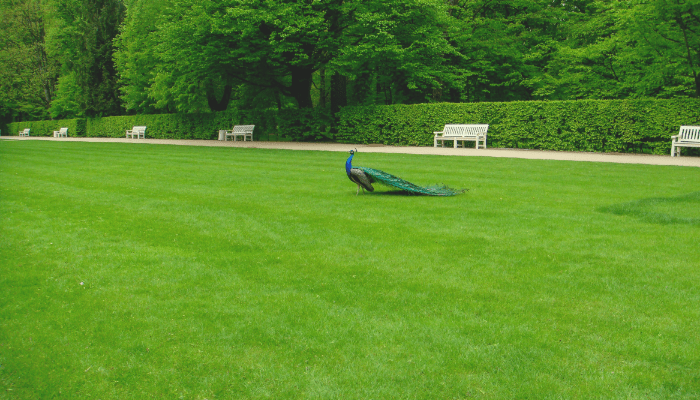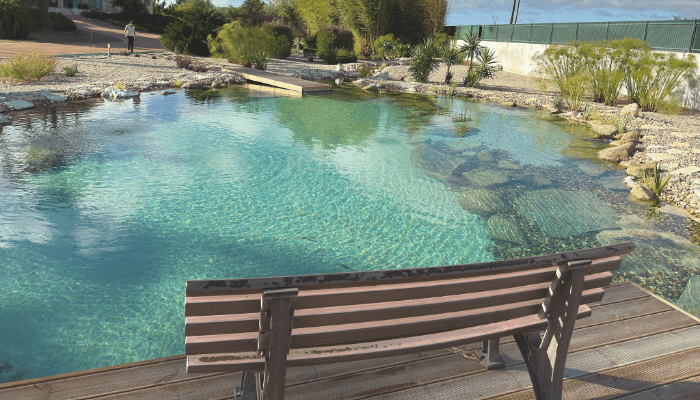Key Takeaways
- Oxygenating plants are essential for small ponds, keeping water clear, balanced, and algae-free without pumps.
- They release oxygen, absorb excess nutrients, compete with algae, and support fish, bacteria, and overall pond health.
- Top picks: Hornwort, Water Thyme, Eelgrass, Elodea canadensis, and Water Milfoil.
- Plant at correct depths: floaters (15-30 cm), rooted oxygenators (30-60 cm).
- Use baskets for control or plant freely for a natural look; give most species 4-6 hours of sun.
- Prune regularly because unchecked growth can overwhelm small ponds.
- One bunch of oxygenators per square foot of surface area is a good starting point.
- Best results come from mixing submerged oxygenators with floating and marginal plants for a layered, self-sustaining ecosystem.

Water without oxygen is like an office without coffee. Stagnant, unproductive, and possibly fatal.
Sounds dramatic? Maybe a little. But if you’ve got a small pond or backyard water feature, oxygenating plants aren’t a nice-to-have. They’re essential. Without them, you’re left with green soup, foul smells, and fish gasping for air like they just ran a marathon.
The wild part? A lot of pond owners still rely entirely on pumps or filters. That’s like using a leaf blower to clean your keyboard. Effective in theory. Overkill in practice. The right plants do the same job without noise, electricity, or constant maintenance.
In this guide, you’re not getting fluff or vague advice. We’re diving straight into what plants actually work, how to plant and care for them, and how many you really need to keep your pond crystal clear and self-sustaining. We’ll also bust a few myths like the idea that tossing in a random weed will magically fix your water overnight.
So if you’re tired of murky water, buzzing equipment, or playing guesswork with your pond’s health, stick around. This is how you build a low-maintenance, oxygen-rich pond that thrives all season long, without the drama.

What Do Oxygenating Plants Actually Do?
Think of them as the lungs of your pond. Quiet, efficient, and completely underappreciated.
Oxygenating plants photosynthesize underwater, releasing oxygen directly into the water column. That oxygen doesn’t just make fish happy. It supports every layer of the aquatic ecosystem: bacteria that break down waste, invertebrates that keep the base of the food chain humming, and the general balance of nutrients in the pond.
They’re also natural filtration systems. As they grow, they absorb nitrates, phosphates, and other compounds that fuel algae blooms. More plants = fewer green water headaches.
Bonus: they compete with string algae for nutrients and space. You know that weird green hair that clings to rocks like it’s auditioning for a shampoo commercial? These plants help keep it in check.

Top Oxygenating Plants for Small Ponds
Not all oxygenators are created equal. Some take over like an unpaid intern with something to prove. Others barely survive a warm weekend. Here are the real MVPs: tested, resilient, and ready to work.
1. Hornwort (Ceratophyllum demersum)
It floats. It sinks. It grows fast. It doesn’t care if it’s planted or not. Hornwort is a low-maintenance beast. Perfect for beginners, it thrives in most pond conditions and doesn’t require soil. Just drop it in.
Best for: wildlife ponds, container ponds, shaded areas
Watch out for: rapid growth. Trim regularly or it’ll form a green jungle
2. Water Thyme (Hydrilla verticillata)
If your pond is more aquarium-sized than garden-sized, this one’s your friend. Dense, feather-like leaves create shelter for baby fish while quietly pumping out oxygen.
Best for: shallow ponds under 50cm deep
Watch out for: invasiveness in warmer climates. Plant in baskets if you’re worried
3. Eelgrass (Vallisneria spiralis)
Tall, elegant leaves sway with the current like aquatic grass in slow motion. This plant roots into the substrate and works well in deeper zones of small ponds.
Best for: medium-depth ponds, natural-looking ponds
Watch out for: snails love it, could be a pro or a con depending on your setup
4. Elodea canadensis (Canadian Pondweed)
A classic. The golden retriever of oxygenators which is reliable, fast-growing, always ready to do its job. Just don’t let it take over, because it will try.
Best for: beginner ponds, koi setups
Watch out for: overgrowth in warm, nutrient-rich water
5. Water Milfoil (Myriophyllum aquaticum)
Soft and feathered, it brings texture to your pond while oxygenating below the surface. It looks delicate but grows fast, great for covering open water quickly.
Best for: mixed plant zones, formal ponds
Watch out for: some species are invasive, buy from reputable native plant suppliers

How to Plant and Care for Oxygenating Plants
Spoiler: it’s not complicated. But that doesn’t mean you should toss them in like salad and hope for the best.
Depth Matters
Each plant has its own comfort zone. Hornwort? Totally fine floating near the surface. Vallisneria? Wants its roots in deeper zones. Check labels or ask the supplier, don’t assume they all like the same conditions.
General rule:
- Floaters: 15-30 cm deep
- Rooted oxygenators: 30-60 cm deep
Containers vs. Free Planting
Containers give you control. They stop spread, simplify seasonal cleanup, and keep your fish from uprooting everything out of spite. Free planting, though, looks more natural and requires less setup.
Choose what fits your style, and patience.
Sunlight = Growth
Most oxygenators need at least 4-6 hours of sun. Less light? Go with shade-tolerant plants like Hornwort or Elodea. But even those slow down when things get gloomy.
Tip: in shaded ponds, go heavier on planting density to compensate for slower growth.
Pruning Isn’t Optional
Let them grow unchecked, and you’ll wake up to a pond that looks like an overgrown terrarium. Cut them back regularly, monthly in summer is a good rhythm. Don’t worry, they’ll bounce back fast.
How to Oxygenate a Small Pond Without a Pump
Yes, it’s possible. No, your fish won’t suffocate. If you plant wisely.
A well-balanced small pond with enough oxygenators can fully support itself without a pump. The key is surface movement + submerged plant growth. Add a few marginal plants around the edges to shade the water and slow evaporation, and you’ve got yourself a zero-electricity ecosystem.
That said, don’t go rogue and ignore everything else. Skimming debris, managing fish load, and watching nutrient levels still matter. But the plants do the heavy lifting if you set them up right.
Start with one bunch of oxygenators per square foot of surface area. Adjust from there. If the water stays clear and you don’t see your fish gasping near the surface, you’re in the sweet spot.
Do Oxygenating Plants Actually Clean the Water?
Not like a pool filter. But also yes.
Here’s how it works:
- They absorb excess nutrients that algae love.
- They release oxygen that supports good bacteria.
- They create shade that slows algae growth.
- They trap suspended particles, clearing the water.
They won’t magically reverse a pea soup disaster overnight, but over time, they build a healthy underwater environment that naturally stays balanced.
For murky water: pair oxygenating plants with surface floaters (like duckweed or water lettuce) and marginal plants around the edge. Together, they create a multi-layered defense system against algae and nutrient overload.

Tips for Small Ponds and Mini Water Gardens
Size doesn’t matter, placement does. Here’s how to make the most of limited space:
- Use baskets to group oxygenators in small zones. Makes maintenance easier and looks tidy.
- Mix plant types: a few submerged, a few floating, a few marginal = balanced systems.
- Start small but plan for growth. These plants expand fast in the right conditions.
- Monitor water clarity weekly. Slight cloudiness is fine. Milky or green? Reassess plant balance.
- Avoid overstocking fish. More fish = more waste = more nutrients = more algae.
And remember: these plants aren’t decoration. They’re infrastructure. Functional, living, beautiful infrastructure.
Conclusion
Your pond doesn’t need to look like a Japanese Zen masterpiece. But it also shouldn’t resemble a neglected bowl of algae smoothie.
With just a handful of well-chosen oxygenating plants, you can transform cloudy, stagnant water into a clean, balanced, thriving ecosystem. It’s not about cramming in as many plants as possible. It’s about planting smart. About knowing what works, where to place it, and how to let nature do the heavy lifting.
Start small. Add a few plants. Watch what happens. You’ll notice the water clearing up, fish becoming more active, and the whole system stabilizing without needing a tangle of cords or a monthly maintenance plan.
Less noise. More life. That’s the power of oxygenating plants.
And hey, if your pond starts getting compliments from the neighborhood ducks? You’ll know you did it right.
Want a clear, healthy pond without the noise or hassle?
Oásis Biosistema designs self-sustaining water features using natural filtration, layered plant systems, and eco-friendly design and no pump required.
FAQ
What pond plants produce the most oxygen?
The best oxygen-producing pond plants include hornwort, anacharis (Elodea), waterweed, and eelgrass (Vallisneria). These submerged plants release oxygen directly into the water during photosynthesis, helping support fish and maintain a balanced pond ecosystem.
How do you oxygenate a small pond?
To oxygenate a small pond, add submerged oxygenating plants, install a small fountain or waterfall, or use an air pump with a diffuser. These methods increase water movement and surface contact with air, boosting oxygen levels for fish and aquatic life.
What are the best plants for small ponds?
Top plants for small ponds include water lilies, dwarf cattails, pickerelweed, hornwort, and anacharis. These provide oxygen, shade, and shelter for pond life while helping control algae by reducing excess nutrients and blocking sunlight.
Will oxygenating plants clear my pond?
Oxygenating plants can help clear pond water by competing with algae for nutrients and releasing oxygen to support beneficial bacteria. While they improve water quality, they work best alongside proper filtration and regular pond maintenance.



